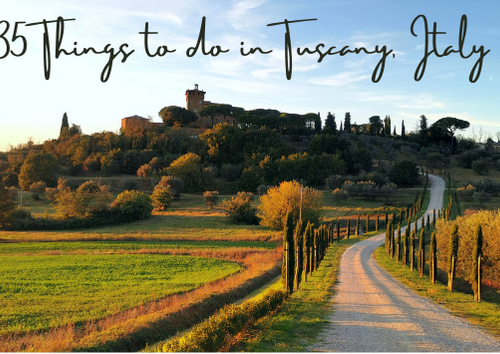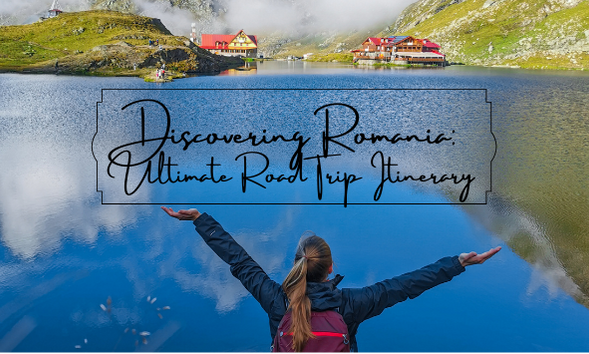
Ultimate “Best of” Romania Road Trip Itinerary
Wild landscapes, deep forests, diverse wildlife, charming cities, and medieval castles: Romania has it all. Although still largely off the radar of many tourists, it has so much to offer! No matter if you are a nature-lover or city-tripper, Romania should make it on your bucket list. Romania is a big country with lots to offer but has a rather underwhelming public transportation system. This makes it a perfect destination for a road trip. This post will provide you with all important information, inspiration & insider tips to help you plan your ultimate Romania road trip itinerary.
What is Romania best known for?
To many, the first thing that comes to mind when thinking of Romania is Dracula. However, there are many more things to do while in Romania than visiting Bran Castle (allegedly Dracula’s Castle).
For nature-lovers
Romania has lots to offer in terms of mountains, lakes, rivers, and wildlife. The Carpathian Mountains stretch through Central and Eastern Europe; the awesome part is that about 50% of it is located in Romania! This means hikers paradise! From the Bucegi Mountains to Piatra Craiuliu and Ceahlau – Romania offers many well-marked trails, catering to all difficulty levels. Furthermore, Romania is home to the largest free-roaming brown bear population in Europe! Many local guides offer bear-watching tours from Brasov.
For city-trippers
No matter if Sibiu, Sighisoara, Cluj-Napoca, or Bucharest – the various cities in Romania all have their own vibe and are well-worth a city trip. A colorful history, hip cafés, boutiques, and various events all year round: there is something for every city-lover, to include in your Romania road trip itinerary.
For culinary-gourmets
Through the centuries, Romania witnessed a very diverse influence of cultures and peoples either settling in Romania or trying to conquer it. These influences can also be felt in its cuisine, which is a rich mix of local Romanian dishes, as well as Balkan, Hungarian, Turkish, and some German elements. Also, make sure to try the high-quality Romanian beers and wines!
For culture & history-fans
If you love history and culture, you will see that Romania has lots to offer in terms of museums, historical monuments, and castles: Roman ruins, Medieval history, Vlad the Impaler, as well as its more recent Communist past.
For party-people
For those seeking unforgettable nightlife adventures, make sure to hit Bucharest, one of the hippest night-life capitals of Europe. If you love festivals, each year the Untold Festival takes place in Transylvania and has a line-up to die for.
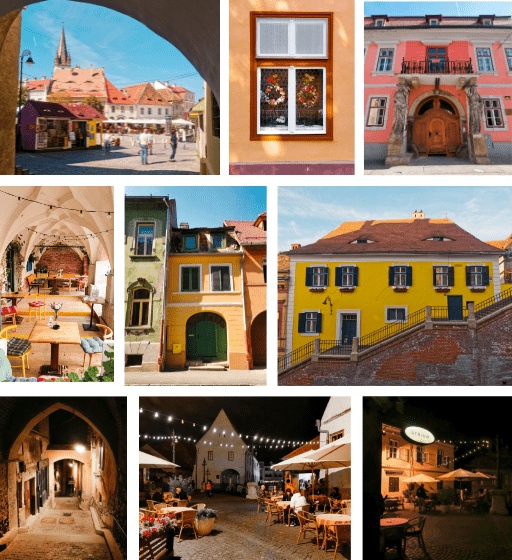
What is the best time to visit Romania for a road trip?
Romania has a classic four-season climate. Summers get very hot – especially in the cities, while winters get very cold and turn Romania into a winter wonderland.
We visited Romania in early September and felt that this time combines the best of both worlds: while it is still nice and warm in most parts of the country, it is not unbearably hot. At the same time, it can get chilly in the evenings – especially in the mountains. Some make sure to pack some extra layers but expect pleasant, mild weather.
Additionally, some main attractions such as the Transfagarasan Highway are only open seasonally (e.g. end of June until the end of October) and tend to get very crowded in the summer months. So overall, we can highly recommend September for your trip.
How many days are enough for Romania?
Romania is a large country in terms of distances and has so much to offer, that you could easily take 4-6 weeks to see (nearly) everything.
Depending on your desired route & plans, I recommend 2 weeks ideally, but no shorter than 1 week. At the bottom of this post, you will find some route alternatives for longer or shorter itineraries, depending on how much time you have in Romania.
What to pack for your Romania Road Trip
Romania is a very mountainous country. Temperatures can fluctuate a lot depending on whether you are in the city or traveling through the mountains – e.g. Transfagarasan Highway, Brasov, etc. If you plan to travel to the mountains, I highly recommend bringing a sweater and light coat even in the summer. In the wintertime, you will definitely need proper winter clothes (heavy jacket, boots, etc).
If you are planning to visit some churches or monasteries, then make sure to pack something that covers shoulders and is not too short on your legs. Many of these institutions ask visitors to dress modestly.
Otherwise, you can pack anything that you would wear at home, with a certain level of comfort in mind, as you will be spending some time in your car to get from A to B. I personally did not pack anything very valuable (e.g. expensive jewelry or watches), in order not to attract attention from the wrong sources.
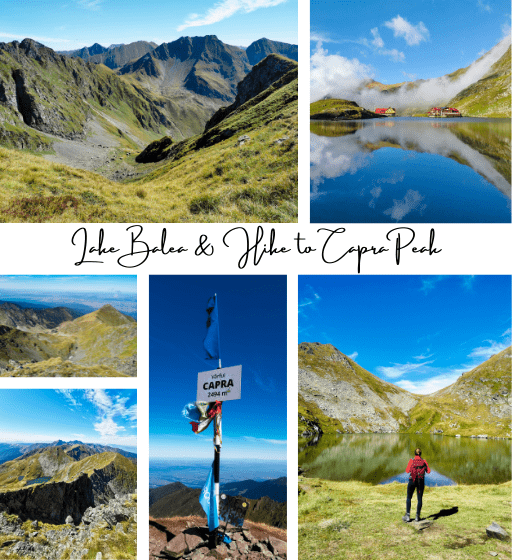
Is it safe to go to Romania?
Although Romania (unjustifiedly) has a reputation in some countries for having a high crime rate etc., we at no point felt unsafe in Romania. If you use your common sense as you would anywhere else, it is highly unlikely that anything will happen to you.
Common sense includes not leaving any valuables visibly in your parked car, not walking in remote areas by yourself in the dark, being mindful of pick-pockets, etc. So yes: it is absolutely safe to go to Romania.
How expensive is a Romania road trip?
Being of the poorest countries in the European Union, Romania is overall a very budget-friendly travel destination. Of course, costs will vary depending on the type of accommodation you choose (i.e. hostel vs. upscale hotel in the center) and if you take any planned tours. Below you will find the average costs we encountered on our trip.
Costs
- On average renting a car will cost you around €20 per day.
- Accommodation in an AirBnB will cost you around €15-€20 per person/night (in shoulder season), depending where you are. While cities are more expensive, the countryside in the north is more affordable.
- Dinner (starter to share, 2 mains & desert to share plus 1-2 beers) will cost around €15 per person.
- A 0.5L beer is usually around €1,50-€2.
- Parking costs €1/hour in the city center.
- Entry tickets to main tourist sights are on average around €8. The cheapest tickets were e.g. to painted monasteries of Bucovina (€2), while the most expensive ticket was Peles Castle (Grand tour for €16).
- Organized trips or excursions will cost you around €40 – €50 for about 2-3 hours (e.g. Bearwatching tour from Brasov)
Driving in Romania: Safety & Other things you should know
Although Romania’s roads are not rated the best in terms of quality, driving in Romania is relatively safe. Most roads are in fairly good condition, especially those connecting larger cities. In the north, the road quality decreased compared to Transylvania but was still fair with the occasional pothole here and there. For an overview of Romanian road quality, check out this map.
Still, there are a few things you should know before starting your Romania road trip.
Important safety driving tips
- The following speed limits apply when driving in Romania:
- 50km/hour in cities;
- 100km/hour on regional roads (one lane each way); and
- 120km/hour on highways.
- There are speed cameras along the road occasionally (these are usually also listed in Google Maps), so you should stick to the limit.
- That being said: most people do not stick to the speed limit. This may at times include some dangerous or impatient surpassing maneuvers, so always be careful and check your side and rear mirrors.
- Many highways pass through towns, meaning you will often have to slow down quite spontaneously for pedestrians crossing the road.
- Always stay alert when driving. It is commonplace to find people walking or riding their bikes on highways or to see horse-drawn carriage or stray dogs crossing out of the blue.
Renting a car in Romania
Most travelers arriving in Romania by plane will likely pick up their rental car there. To help guide your choice of car rental company and things to have in mind, find some tips below:
Car rental requirements
- You must be at least 21 years of age
- There will be a surcharge if you’re under 25
- You must have held your licence for a minimum of 12 months
- An international drivers licence is required for non-EU citizens
- You need to show proof of identity (e.g. valid passport or identity card for EU-citizens)
- The same documents are required for each additional driver
Car rental tips for your Romania road trip
When renting a car, there are a few things to keep in mind:
- If you are renting your car at Bucharest Int’l Airport (OTP), there are only a few rental agencies directly in the airport terminal building. Other (often local) agencies are located near the airport. You will need to walk there, get a cab or grab the shuttle bus, which is a bit of a hassle. Therefore I recommend getting your car from one of the agents in the airport building for a peace-of-mind at arrival. These are Europcar, Budget/Alamo, Avis & Hertz.
- There are some local car rental providers which are usually cheaper in terms of rate they offer. However, we’ve read a few reviews of bad experiences, as several don’t keep up to international standards & services – especially when support is required. Therefore I recommend sticking to the usual suspects.
- When you get your car, make sure to inspect it for any dents, scratches etc. and have the agent mark it on your contract.
- Pick-up and drop-off in the same location is always cheaper. Therefore I recommend you plan a circular road trip route.
- Take photos of the car, the mileage and petrol gauge before leaving the rental place & after dropping your car off.
- If you are not travelling solo, I recommend booking a second driver for your Romania road trip as distances can get long between places. That way you can take turns driving.
- As Romania is part of the EU, you will be able to use your phone’s internet plan from home (if you live in the EU).
- Especially in the north, connectivity can get very patchy with no reception. I recommend downloading Romania offline on Google Maps, to make sure you always have GPS & navigation. This saves you money for getting a GPS with your rental car.
- If you are planning to visit Bucharest at the end of your trip, drop off your car at the airport and take an Uber into the city & back. Drivng in Bucharest is a nightmare – save yourself the hassle!
Food & Drink in Romania: things to try on your road trip
Romania’s cuisine is hearty, dominated by meat and no-fuss. For foodies and those who love to try local foods when traveling, I’ve listed a few things you should try while on your Romania road trip:
Foods
- Sarmale: Considered to be Romania’s national dish, sarmale are cabbage rolles filled with minced meat (mostly pork), mixed with herbs & rice. Sarmale usually come with a portion of Mamaliga (polenta) and sour cream, as well as a red chili. Heaven on a plate!
- Mici: Mici are grilled minced meat rolls with a wonderful smoky, BBQ flavor. They are usually served with fresh white bread and mustard. Costing only about 5 Lei / piece, you can either get them as a Main or just a quick street food snack throughout the day.
- Polenta or Mamaliga: boiled cornmeal. Served as a side to many stews or sarmale, or eaten pure with melted cheese. Mamaliga is a staple of Romanian cuisine.
- Ciorbă: Romanian has wonderful array of hearty soups, often eaten as a starter or light lunch. There are various types of soup – most commonly Ciorba de burta (Tripe soup), Bean soup (Ciorba de Fasole) or chicken noodle soup (Ciorba Radauteana).
- Salata de vinete: roasted eggplant salad is another fantastic appetizer option and a must-try during your trip to Romania. Delicious as a spread on fresh white bread and with fresh tomatoes or Romanian cheese.
- Zacusca: Another delicious vegetable spread made of grilled bell peppers, tomatoes and eggplants. Often served as an appetizer or savory breakfast-spread.
- Papanasi: when heading down desert-lane, Papanasi is one of the first things you should try. Papanasi are fried doughnuts, made from cottage cheese and mostly topped with sweet cream and wild berry jam. Delicious, filling and definately in the soul-food category. We had the best papanasi while in Maramures in northern Romania in the countryside.
Drinks
- Local Beers: Romania has several very good beers that you should try. Our favorites were Ursus (draught & Retro), Ciuc, Bergenbier. There are also many local craft beers such as Hop Hooligans or Palosul lui Stefan.
- Tuica & Palinca: fermented plum liquor & double-fermented Tuica (respectively) are Romania’s national drink. Often served in smaller, family-run bed-&-breakfasts to welcome guests, you should try a shot of this (often-homemade) liquor.
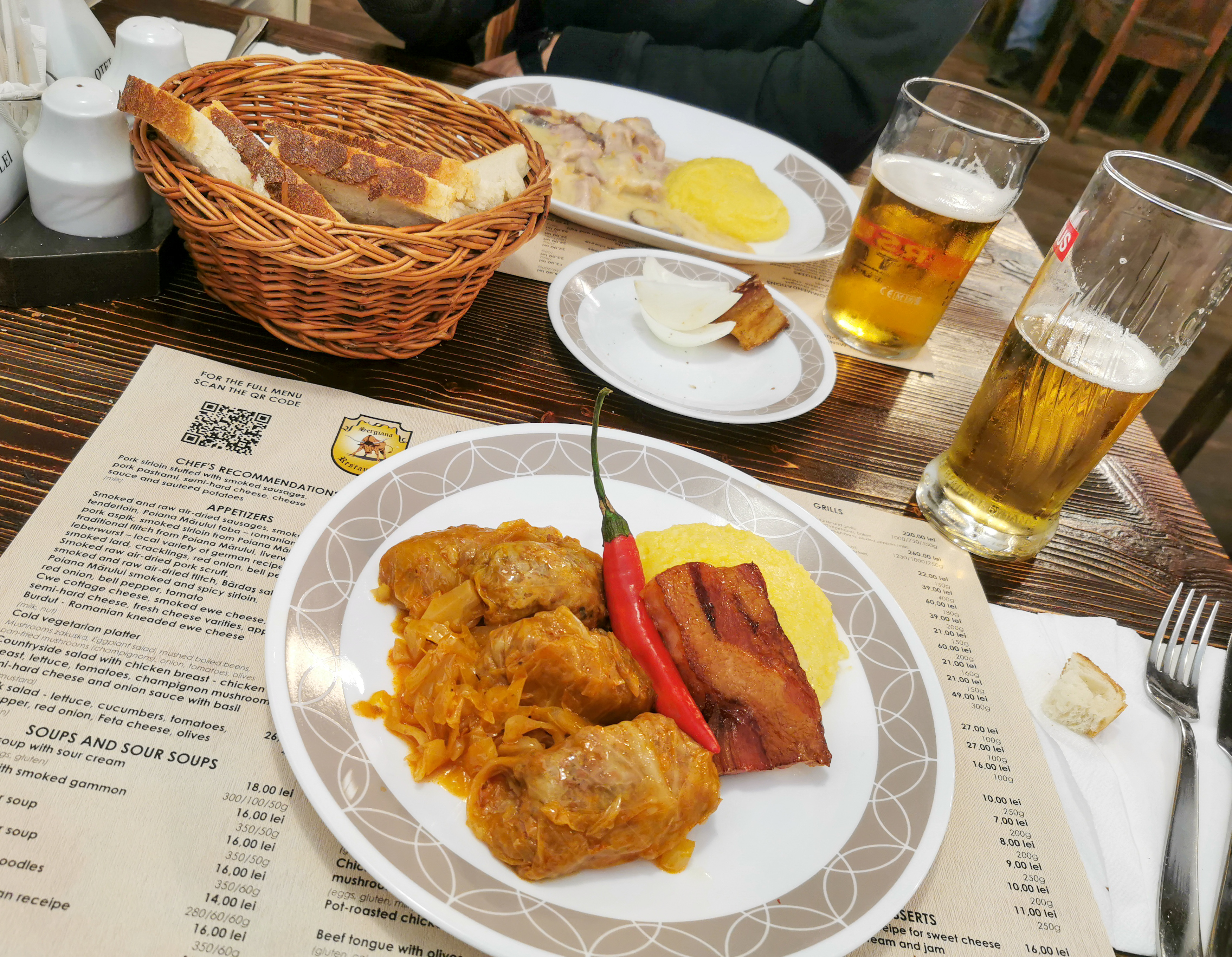
Ultimate 2-week Itinerary for your Romania Road Trip
Our two-week itinerary took us from Bucharest through Transylvania, along the Transfagarasan Highway, to the North in Maramures and Bucovina, and back to Bucharest. For our Google Map click here.
For an overview, below is an overview of where we stayed during our 13 nights in Romania.
- 3 nights in Brasov (area)
- 1 night at Lake Balea (Transfagarasan Highway)
- Sibiu (2 nights)
- Turda or Cluj-Napoca (2 nights)
- 2 nights in Maramures (split between two accommodations)
- Bucovina (split between two accomodations) – 2 nights
- 1 night in Bucharest

Road trip Day 1 | Bucharest to Brasov
Like most passengers arriving in Bucharest, we landed at Otopeni airport and got our rental car there. As mentioned above, we got our car from Enterprise/Alamo, as they have their office directly in the terminal building. Afterward, a shuttle from Enterprise took us to the parking lot to get our car. After checking that everything was fine, we hit the road towards our first destination: Sinaia.
Peles Castle
Sinaia is located at the foot of the beautiful Bucegi mountains. This is where epic Peles Castle is located – an absolute must-see on your Romania road trip! Peles castle was officially inaugurated in 1883 and used to be the summer residence of King Carol I of Romania. Combining a mixture of various European styles (most prominently Italian & German), the castle is beautifully located with a mountainous back-drop.
When visiting the castle you can choose between the smaller tour and the larger tour (40 Lei & 80 Lei respectively). The smaller tour will take you through the ground floor, while the larger tour allows access to the first floor of the palace. If you have a little time & cash to spare, I recommend doing the Grand tour – there are some very nice rooms upstairs.
To take pictures inside, you have to pay a 35 Lei photography fee. However, while visiting the castle, I felt like nobody really checked, so not 100% sure if this was worth it.
Pro tip: the ticket shop only takes cash, so make sure to pick up cash at the airport or in a larger town. There is an ATM machine by Peles Castle, but it has high fees for withdrawal.
Note that Peles Castle is only one of several sights that you visit while at the Castle Complex. There are some more buildings such as Pelisor Castle & Foisor Hunting Lodge, that are also included in your ticket. If you have had enough sightseeing after Peles Castle, you can directly get a bite to eat or a drink at one of the nearby restaurants.
Other things to do in the area
If you arrive early enough, you can still either go on a hike in the Bucegi Mountains and/or take the cable car to the top. The Bucegi mountains are a wonderful piece of the Carpathian Mountains, so if you have a few extra days and love hiking – this is the place to be. For instance, one famous spot to visit is the Bucegi Sphynx.
As the weather was not too fantastic, we hit the road again in the afternoon and headed to Brasov. Our Airbnb host recommended we have dinner at Sergiana, which has delicious, local Romanian cuisine. After dinner, we strolled through Brasov’s city center in the evening.
Summary:
Activities | visit Peles Castle en-route from Bucharest to Brasov. In the evening have dinner in Brasov and stroll through the old town.
Distance | 154km
Drive Time | 2:30 hours
Route | DN1/E60 via Ploiesti, Sinaia
Where to Sleep | AirBnB – “StayPlan Center Theater Brasov All NEW”
Where to Eat | Restaurant Sergiana, Brasov
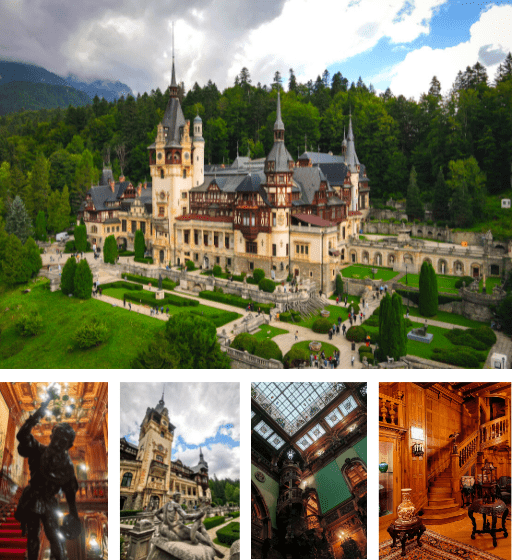
Road trip Day 2 | Brasov City & Bear-Watching Tour
Brasov is located in the central part of Romania, surrounded by the beautiful southern Carpathian Mountains. It is one of the main cities of historic Transylvania. I recommend you spend the first half of the day checking out Brasov city center, while you dedicate the 2nd half of the day to a bear-watching tour!
There are many things to discover:
- Black Church / Biserica Neaga: some sources say that the “black” part comes from a fire that affected most of the city in 1689, while more recent accounts state that its largely due to pollution.
- The main city square / Piata Sfatului: sit in one of the numerous cafés or restaurants and enjoy the beautiful view on the main square. Or grab a coffee and sit by the fountain. Either way a great way to soak up the city vibes.
- A little behind the main square (near Park Gheorghe Dima), you will find two old city gates. Catherine’s Gate / Poarta Ecaterinei and Schei Gate / Poarta Schei. Check both out and then…
- walk down Strade Poarta Schei, pass the Synagogue until you reach tiny Sforii Street / Strada Sforii off to the right. This is the narrowest alley in the city and is decorated and painted on all sides by local artists.
- For a beautiful view over Brasov city center take a ride up to Tampa peak with the cable car. Alternatively you can also hike up. There you will find Brasov’s very own “Hollywood” sign. If you want to hike back down, it takes about 45 minutes (good shoes recommended!)
For lunch, I recommend Ogreada (on the main square), where you will find good local Romanian cuisine. Especially if you like duck, order that – it was delicious!
Bear-watching Tour
In the afternoon, go on a bear-watching tour to the surrounding Carpathian mountains. Most tours leave around 4:30 or 5 pm and will take you for a 45-60 minute drive outside of Brasov into the mountains. After a short walk / hike, you will arrive at a wildlife watching shack/bear hide and have a chance to see bears up close. You will have about 2-3 hours to watch the bears until you get back to Brasov at around 8:30 or 9 pm.
What is important to keep in mind: you will have to sit very quietly in the hide. The animals (bears, foxes etc.) have very sensitive hearing and will not show up if there is too much noise. So make sure you take out your camera in the car in order to avoid loud zipping & velcro noises. Also, I do not really recommend this activity with (small) children, as it may be hard for them to keep quiet over such long periods of time.
Overall, I highly recommend adding this to your Romania road trip itinerary, as it is a beautiful experience! As Romania has one of the largest bear populations in Europe, it is definitely one of the few places where this is so accessible. We booked our tour via Romanian Friend and found it overall good value for money costing €45/person.
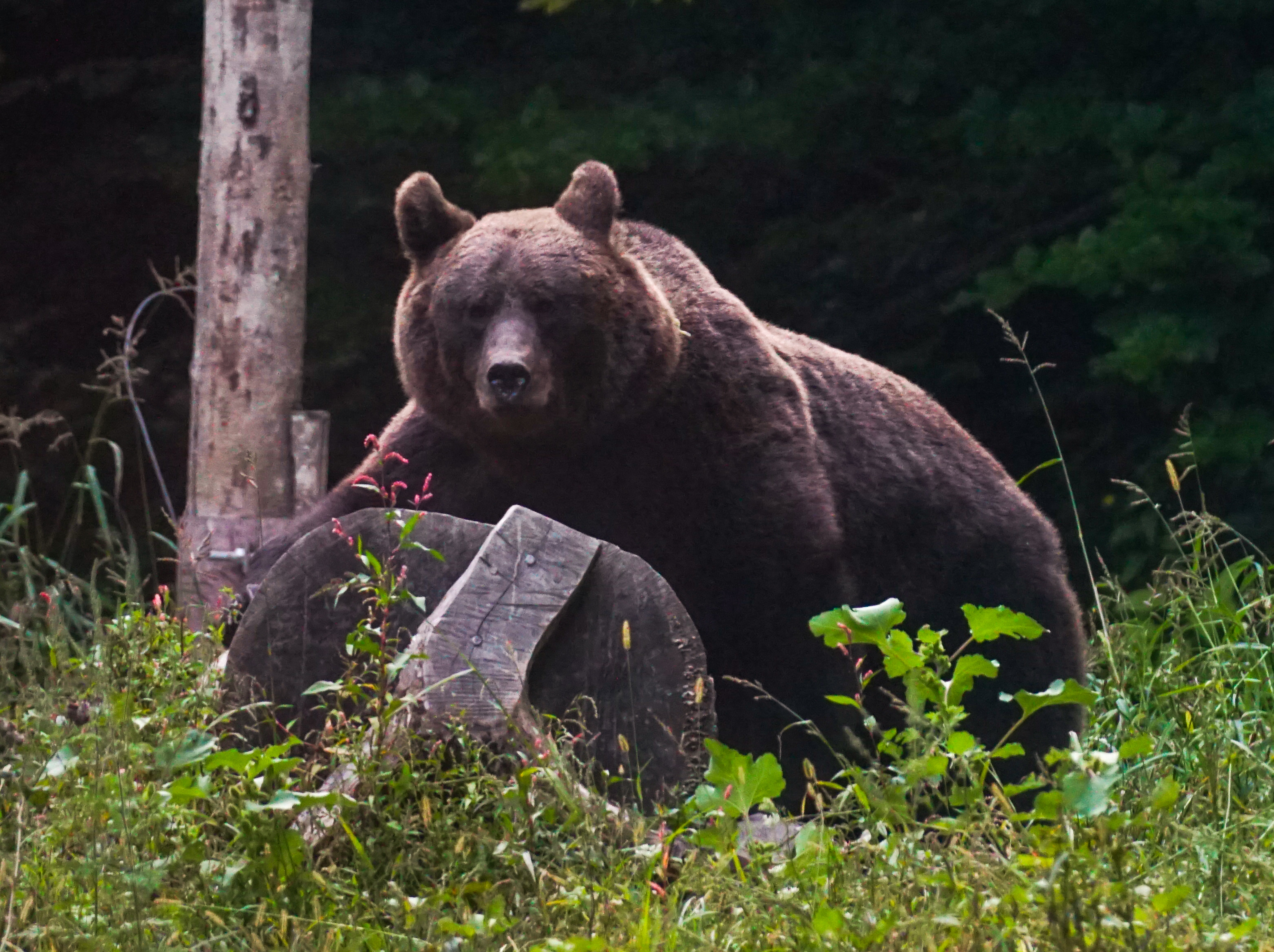
Summary:
Activities | in the morning discover Brasov & do some sightseeing. In the afternoon go for a bear-watching tour in the surroundings of Brasov.
Where to Eat | Ogreada (on the main square) – typical Romanian food. The duck was delicious!
Road trip Day 3 | Hiking in Piatra Craiului (Romanian Carpathians)
If you like nature & the outdoors, head out for a hike in beautiful Piatra Craiului National Park. It is about a 45-minute drive from Brasov.
From Brasov take the highway to Zarnesti until you arrive at Fântâna lui Botorog. You can park your car here (45°32’08.0″N 25°17’32.1″E). Make sure to take enough water. Alternatively, (re-)fill your bottle here before setting out for your hike.
From the car park walk down the road Valea Prapastiilor until you get to the Gorge (Prăpăstiile Zărneștiului). From here follow the path through the Gorge. Yellow markings will take you to Cabana Curmatura (2 – 2:30 hours). At this hut, you can have warm food (e.g. soup) and/or cake. I recommend a piece of apple pie. There is a little bonus surprise effect 🙂
After enjoying the view and (hopefully) sun at the cabin, make your way back down behind the cabin. Pass by Poiana Zănoaga, and back down to Fântâna lui Botorog. If you have knee or ankle problems take along hiking poles, as the descent back down to the parking is relatively steep. If you don’t have any, don’t worry, it is also manageable without (but just not as pleasant).
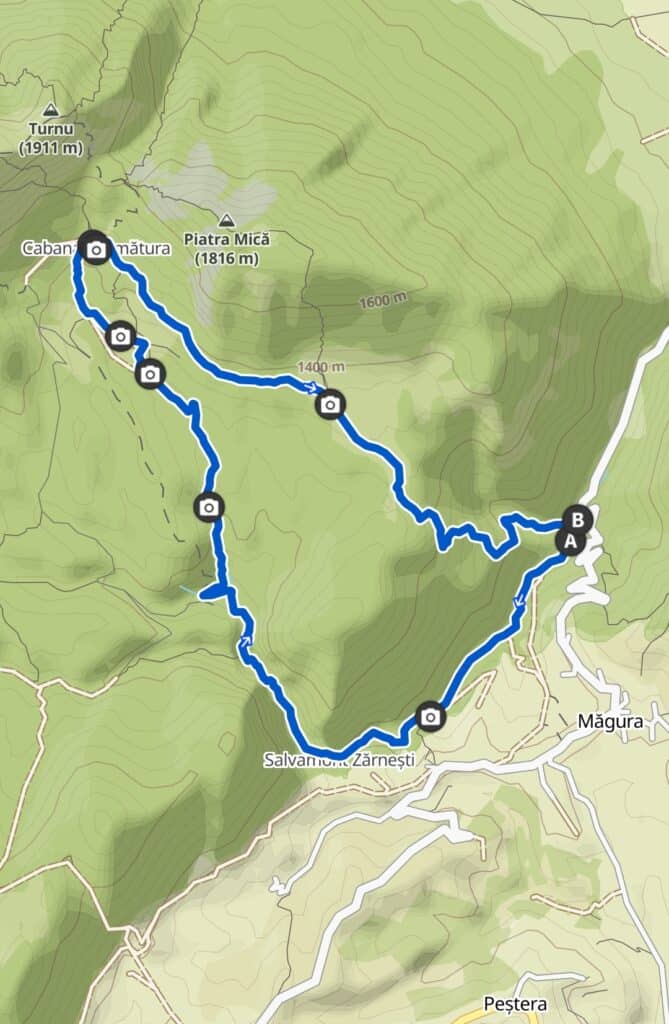
After the hike head back to Brasov. You can take a small detour via Bran Castle, which is en-route. Bran Castle – also nicknamed Dracula’s Castle – was Bram Stroker’s inspiration for his novel Dracula. Unlike widely assumed, Vlad the Impaler never actually lived there. At most he was imprisoned for some weeks. Therefore, we opted not to visit the castle & leave this out of our Romania road trip itinerary. The castle (and the whole town) is very full and touristy. Instead we chose to visit Hunedoara Castle some days later (see further along in our trip).
In the evening, grab dinner at “Dei Frati”, the best Italian restaurant in town. Call for a reservation, as it gets very full in the evening!
Summary:
Distance | 73 km
Drive Time | 1:45 hours
Route | Brasov via Zarnesti to Piatra Craiului National Park (parking near Fontana Botorog). On the way back to Brasov drive via Bran to maybe check out Bran castle (Dracula’s Castle).
Where to Eat | For the best Italian food in Brasov go to “Dei Frati”. I recommend getting a reservation, they were quite booked.
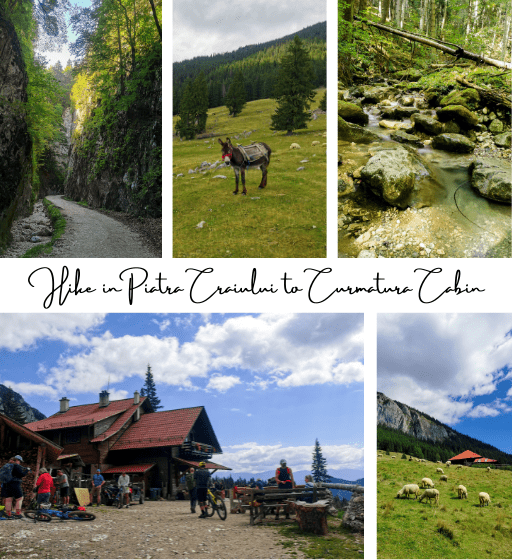
Road trip Day 4 | Driving the Transfagarasan Highway – Romania’s most beautiful road
After leaving Brasov, one of the highlights on your Romania road trip awaits. The spectacular Transfagarasan Highway. Named the most beautiful highway in the world by Top Gear, the Transfagarasan is not to be missed on any Romania itinerary!
Important to note: the Transfagarasan Highway is only open from June to October. If you want to experience this fantastic driving experience, make sure you visit in late spring to early autumn.
On the northern side of the Highway (DN7C), you will find the town Cârțișoara. Shop any needed supplies here (if you are planning to camp) and fuel up. There are no gas stations or stocked supermarkets on the Transfagarasan.
To the south of the Transfagarasan is the town Argeș. The entire Highway is around 80km long. Most say that the most beautiful part is between Cartisoara and Balea lake.
There are several highlights along the way:
- Cascada Balea (Balea Waterfall): you can take a mini 30-45 Minute hike to the waterfall (one-way) & get a bite to eat (or sleep at) Hotel Bâlea Cascadă.
- Balea Lake: this picture perfect mountain lake sits at the top of the Transfagarasan. There are many souvenirs shops and food stands here for shopping or eating. Alternatively, take a stroll to and around the lake. You can even go on a short Zipline ride. I highly recommend staying the night here as it is a beautiful spot and there are lots of hiking routes starting here (see Day 5).
- Cascada Capra: another pretty waterfall with plentiful hiking options.
- Lake Vidraru, with a huge dam, many huts & accommodation options, as well as numerous hiking trails.
- Poenari Castle Citadel / Cetatea Poienari: the ruins of a castle, which was home to Vlad the Impaler (Dracula) during the 15th century. It is reachable by climbing 1,480 stairs.
If you enjoy wildlife sightings: there have been several bear sightings along the Transfagarasan Highway over the years. We even found bear footprints outside the Cabana Balea Lac in the morning after we stayed there. But trust me, you don’t necessarily want to meet a bear out alone on your hike.
Please note: if you hike in the Fagarasan Mountains always be watchful for wildlife such as bears. Make sure you get acquainted with what to do in case of a bear sighting; we did receive a “Bear alarm” via SMS while we were out in nature.
Summary:
Distance | 133 km
Drive Time | 2:24 (plan more time here for slow driving on the Highway itself & frequent photo stops ;-))
Route | DN1/E68 & Transfăgărășan/DN7C
Where to Sleep | Cabana Balea Lac (bed-and-breakfast)
Where to Eat | Cabana Balea Lac Restaurant
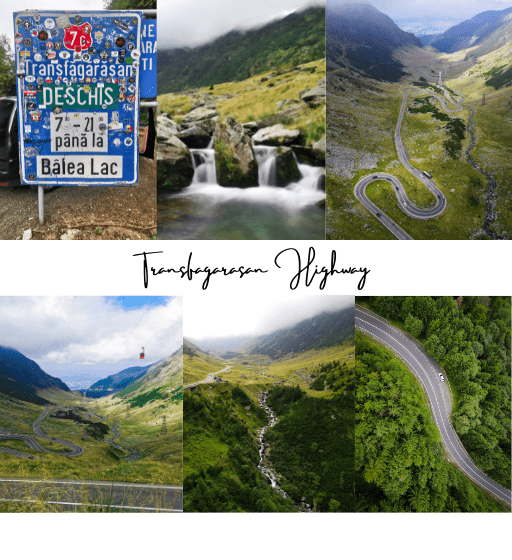
Road trip Day 5 | Hiking in the beautiful Fagaras Mountains
If you want to spike your Romania road trip with another hike, today is the right time to do so!
After waking up and having a hearty breakfast we hiked up to Saua Caprei (Goat Saddle) and on to beautiful Capra Lake (Lacul Capra). Next we hiked up the Capra Peak & adjacent Vârful Vânătoarea lui Buteanu. We took the way back down over Saua Vaiuga via a mini-glacier and back down to Balea Lake. Overall, the hike took us around 4:30 hours (see map below & our komoot link for exact itinerary & GPS data).
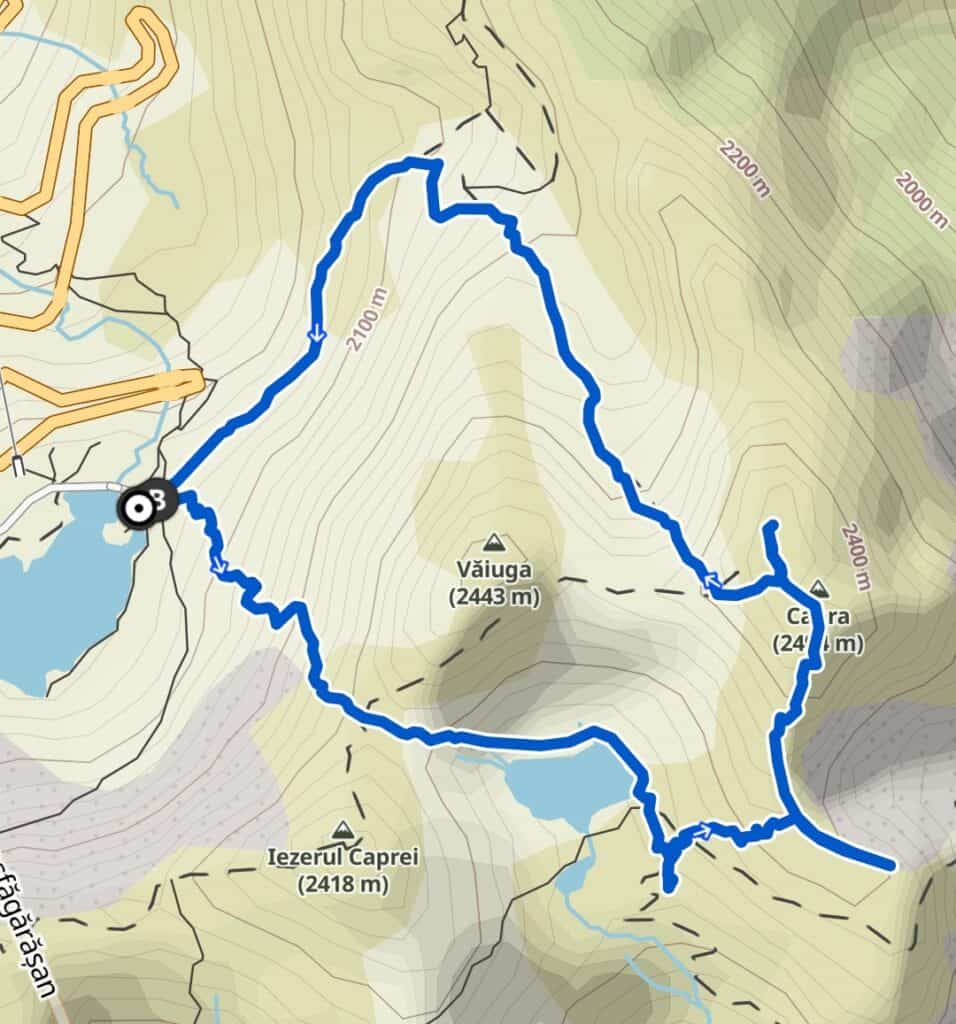
After relaxing in the sun by the lake for some time we hit the road towards our next destination: Sibiu.
En-route to Sibiu you can take a small detour to Castelul de Lut Valea Zânelor. Although it looks very epic on google images, this “clay castle” seems more like an amusement park for kids, which still has to be completed. Therefore, I would not really recommend stopping by on your Romania road trip, unless you are traveling with kids.
We reached Sibiu in the late afternoon and checked into our Apartment. After freshening up we set out to explore Sibiu in the evening and were really impressed! There were 3 different festivals going on in parallel: a food festival, a music festival, and a film festival. The town was bustling with life and things to do. We grabbed some dinner and then strolled through the lit streets.
Summary:
Distance | 94 km
Drive Time | 1:54 hours
Route | Transfăgărășan/DN7C, DJ105J (to Castelul de Lut Valea Zanelor), & main highway to Sibiu DN1/E68
Where to Sleep | Amedeea’s Apartment: super central location, free parking in the street, great host.
Where to Eat & Drink | JAP (Piața Mică 9) – very central, modern, mixed cuisine, good cocktails & nice outside seating area. Get a drink at Atrium bar for a relaxing glass of wine by the bridge.
Road trip Day 6 | Exploring charming Sibiu, Romania
Explore Sibiu today. It was one of our favorite stops during our Romania road trip and is definately a must-see while in Transylvania. Nicknamed the “city with eyes” (look up at the rooftops to know why), Sibiu’s history goes back to the 12th century. Because of its passing through Roman, Hungarian, and German hands over the centuries, Sibiu is very worth visiting with its array of museums, sites & beautiful architecture.
It has a very rich gastronomic offering, its old city center is also on the list to become a UNESCO World Heritage site and Sibiu was named European Culture Capital in 2007. Furthermore, Sibiu is a very walkable city so you will be able to see most things on a stroll through the streets.
On your walk through the city make sure to check out:
- There are 3 main squares: Piata Mare, Piata Mica & Piata Huet. All are situated beautifully in close proximity of another with beautiful buildings lining each square.
- The Bridge of Lies: a beautiful pedestrian cast-iron bridge crossing Strada Oncei & connecting Piata Mica & Piata Huet. Its name derives from the multiple legends surrounding the bridge – have your pick 😉
- Strada Cetății: named one of the most beautiful streets of Sibiu. Head south off Piata Mare to walk by the old city walls and fortifications.
- Next, pass Piata Unirii and head up Strada Ioan Lupas by the park. Stop for a coffee or drink at Café Consomme, a vintage café with a nice atmosphere.
- After stopping at Consommé, turn right into Strada Mitropoliei & check out the Cathedral of the Holy Trinity (Sfanta Treime) as well as the Art Nouveau buildings.
- Right after the pink building with its beautiful Art Nouveau facade, take the little alleyway in until you reach Street Xenopol. Head towards Strada Tribunei, turn left and you will find yourself on the Main street Strada Nicolae Balcescu, lined with stores, café and restaurants on both sides.
Museums
- If you are interested in museums, make sure to check out the ASTRA National Museum Complex. It is a huge open-air museum boasting a wide selection of Romanian traditional buildings, culture, folklore and anthropological exhibitions.
- The Brukenthal Museum – the first of its kind and oldest in Romania – features a large collection of Art, old books, etc. & is scattered over different locations in the city.
Summary:
Where to Eat | Hermania – to get a feel for the German roots of Sibiu, enjoy a mix between Romanian and German-inspired dishes in a beer garden feeling with a Romanian touch.
Where to Drink | House of Ellixirz – Cocktail Bar: great cocktails, great atmosphere, and very nice owners!
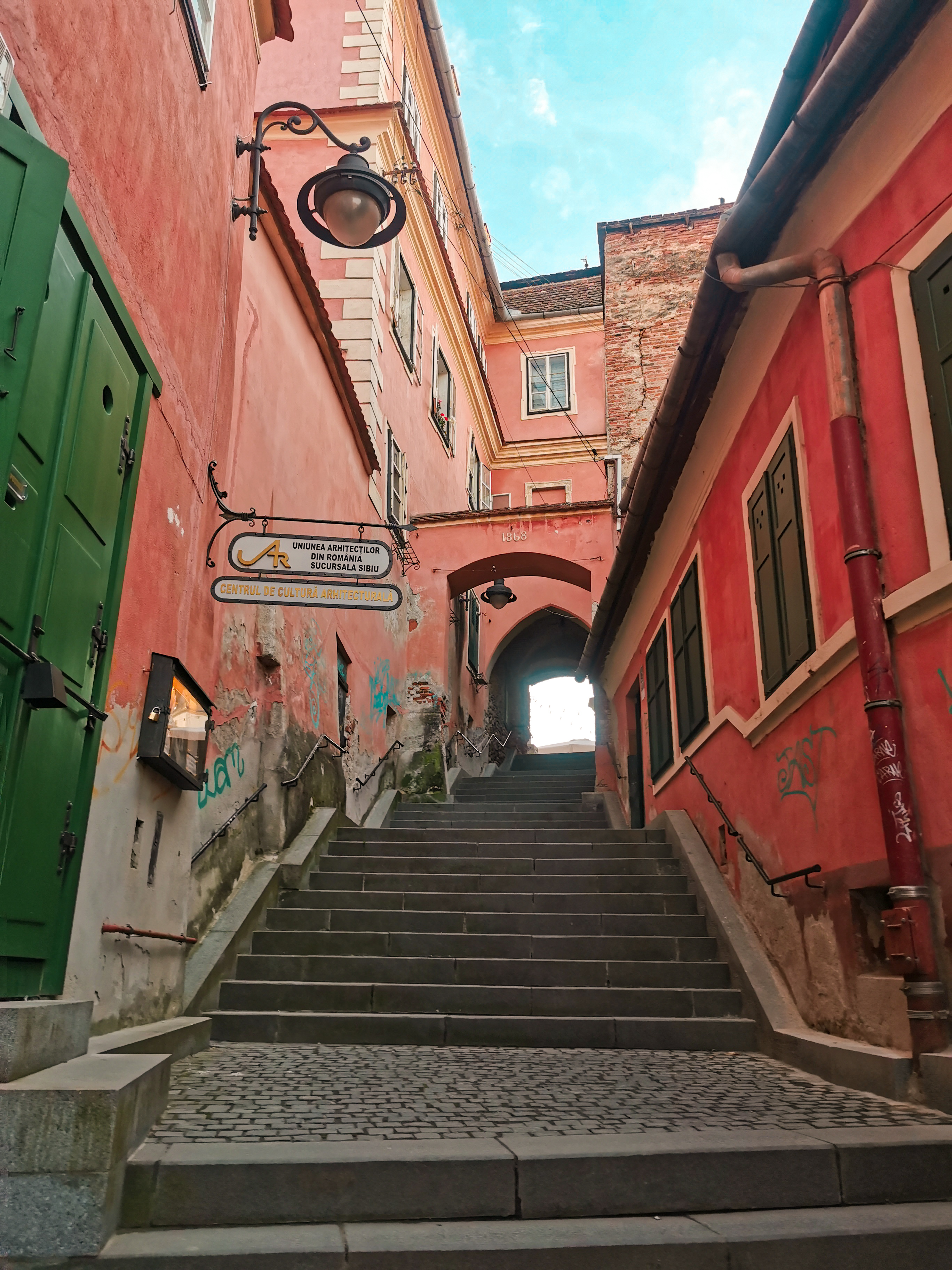
Road trip Day 7 | Visiting Medieval Hunedoara Castle
Corvin’s Castle
Today’s itinerary will take you to one of Romania’s most iconic castles: Corvin’s Castle in Hunedoara. Located a little off the beaten path, it is well worth a detour. With its large castle moat, its many towers, and bridge it looks like straight out of Bram Stroker’s novel – but without the crowds 😉 This was also one of our main factors in deciding whether to visit Corvin’s Castle or Bran Castle. Corvin’s Castle is much less touristy and you get a “real feel” for its vivid history.
Park your car in Strada 9 Mai and walk to Corvin’s Castle (just about 5 minutes away). Tickets are 20 Lei / Person and take you through the entire castle. There are a few smaller exhibits in different rooms about Medieval torture instruments & dungeons, as well as old furniture and paintings in the upper rooms of the castle. While not as well prepped or maintained as other popular sites such as Peles or Bran castle, it still feels authentic and you can almost breathe in the history.
Things to do in Hunedoara area
There are a few other things to do in the area around Hunedoara if you fancy staying a night. You can visit nearby Deva Castle, perched upon a hill and reachable via a mini cable car or 30 minutes walk/hike. Alternatively, for history lovers, check out Sarmisegetuza Regia, the ancient Roman capital of the Dacia Region. It’s well preserved and definitely worth a visit.
If you enjoy the outdoors, you will find Cincis Lake nearby, where you can just relax or have a swim in the summer. Finally, if you want to get in another hike, you must pay a visit to the beautiful Retezat mountains, featuring some of Romania’s most beautiful hiking trails. There are several routes for both experienced and inexperienced hikers. Some of the most popular trails will take you to Lakes Bucura or Galesu, or to Papusa or Peleaga Peaks.
As our destination for the day was Turda, we headed north after visiting Corvin’s Castle. We had originally planned to stay in Cluj Napoca for 2 nights, however, we were unaware of the Untold Festival taking place at the time (so prices for all accommodation were skyrocketing).
If you are a lover of good house & electro music, I definitely recommend you check this festival out – the Lineup looked insane!
Staying in Turda was practical for another reason: the next day we had several activities planned there. In the town itself, there are few things to do, but the surroundings are filled with fun activities.
Summary:
Distance | 278 km
Drive Time | 3:09 hours
Route | From Sibiu take highway A1 to Hunedoara & then follow A10 up to Turda
Where to Sleep | Belle View Apart Hotel in Turda
Where to Eat | There are not many places to eat, but we chose “Veranda” & it seemed like the place to be. The food was good.
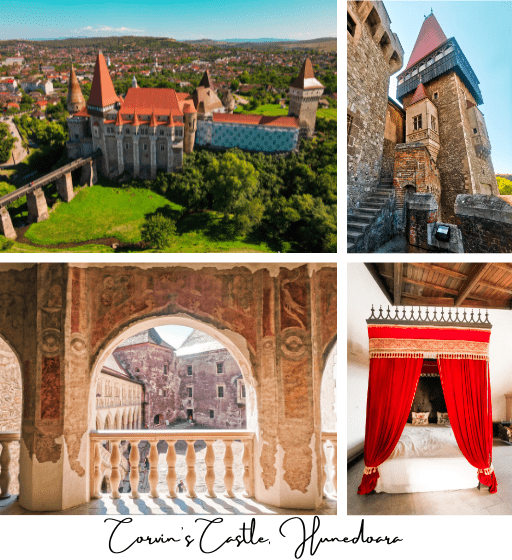
Road trip Day 8 | Turda: Gorge, Salt Mine & Wine-tasting
Turda Gorge
Today we had several cool activities lined up surrounding Turda. In the morning we drove to Turda Gorge (Cheile Turzii) where you can go on an easy 1,5 – 2 hour hike through the Gorge. The gorge is about 1250 meters long and the trail passes by a small river, which you cross several times over wooded suspension bridges. It was quite busy, but still very beautiful nature and recommended to walk through.
Turda Salt Mine
In the afternoon, head to Turda Salt Mine (Salina Turda), the world’s first and largest underground amusement park. We were a little skeptical at first, but then completely blown away. This is a must-see on your Romania road trip itinerary! Especially if traveling with kids. Entry tickets are a little pricey at 60 Lei/person, but it is very worth it! And as a little bonus, while in the mine you will breathe in salty air – which is very healthy for your respiratory system.
Turda Salt mine is an ancient salt mine (first mentioned in 1075 AD), that has been used for salt extraction since antiquity and all the way through the middle ages until modern days in 1932. It boasts several large chambers and some smaller rooms (e.g. Crivac room), showing old instruments used in the salt mining process – unique in all of Romania and Europe.
However our highlight of Turda Mine was its large underground amusement park. The Josef Mine, reachable via Franz Josef Gallery is the first “wow” experience. Measuring 112 meters depth and 67 meters width, the bottom of this large chamber is full of cool activities, including a cinema, mini-golf court, ping-pong & pool tables, etc. The mere size & dimension is just overwhelming! Indulge in a couple of activities and have fun!
Once you have satisfied your inner child, descending one level deeper, you will find the bell mine (90 by 87 meters). The bottom of the chamber is covered by an underground lake (between 0.5 to 8 meters deep), complete with rowboat rental.
After spending about 2-3 hours there, it is nice to see daylight again. Head right across the road for some delicious food at Restaurant Sarea-n Bucate and try some local wines from the Turda wineries La Salina & Crama Salina.
Summary:
Distance | 34 km
Drive Time | 0:55 hours
Route | From Turda city center head via 107L & 103G to Turda Gorge Parking. Afterward, head back to Turda and the 161B to Turda Salt Mine. If you are traveling from Cluj Napoca, add about 34 km (one-way) to Turda, via DN1/E60/E81
Where to Eat | Sarea-n Bucate Restaurant, across from Turda Salt Mine
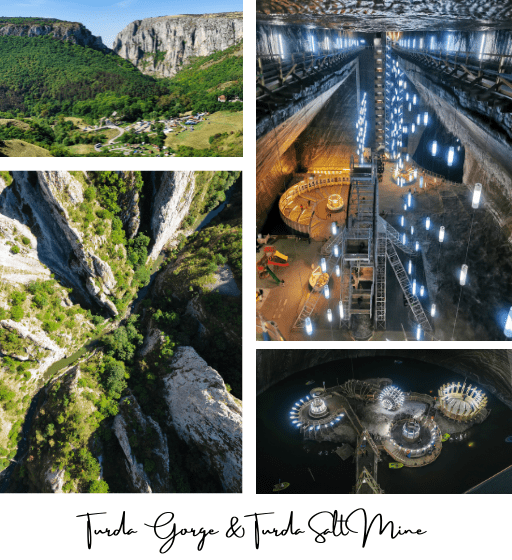
Road trip Day 9 | From Turda (or Cluj-Napoca) to Maramures
The next couple of days will take you into the more remote parts of northern Romania to Maramures & Bucovina.
Maramures is a beautiful, hilly region in the northwest, known for its unique, century-old wooden churches, scattered among traditional villages. Simple on the outside, the insides boast rich, biblical frescos partially dating back until the 14th century. It is also here in Maramures, where you will experience true Romanian hospitality & kindness.
The drive up to Maramures is a little lengthier, so plan enough time in order not to rush. On your way up, admire the beautiful landscapes and notice how everything will become a little remoter and slow down. Also, the quality of the roads will noticeably worsen the further north you get.
Upon arrival in the (early) afternoon, take a walk around the countryside, soak up the vistas and just slow down a little. You will quickly notice that the pace of life is slower in Maramures: a good opportunity for some welcome downtime on your eventful Romania road trip.
Throughout Maramures, there are many small family-run pensions with simple rooms, decorated with lovely details of traditional Romanian country life. To truly experience Maramures, I recommend you stay at one of these “Pensiuneas”, enjoy the home-cooked, traditional Romanian dinners, and experience Romanian hospitality at its best.
Summary:
Distance | 204 km
Drive Time | 3:21 hours
Route | from Turda via DN18B
Where to Sleep | Acasa in Maramures, Feresti – absolute recommendation: Ileana will take care of you very sweetly! Upon arrival, we were greeted with home-baked cake, coffee & palinka. And she cooked us a delicious, traditional dinner & breakfast the next day. Also, Feresti is a good place from which to explore the area.
Where to Eat | Ask your pension if they cook dinner, if not ask for a local recommendation
Road trip Day 10 | Wooden Churches of Maramures – Romania’s traditional North
Today it’s time to explore the many villages and traditional wooden churches in Maramures. This is definitely one of the “scenic drive” parts of your Romania road trip! In the Maramures Region, there are a total of about 60 wooden churches (45 of which are in Romania and 15 in Ukraine). There are 8 churches in Maramures that have been listed as UNESCO World Heritage Sites since 1999:
- Wooden church in Barsana (1720)
- Budesti (1643)
- Desesti (1770)
- Ieud (around 1620)
- Plopis (1796/98)
- Poienile Izei (1604)
- Rogoz (1663)
- Surdesti (1766)
Barsana
Firstly head to Barsana, where you will find Barsana Monastery & old wooden Church in the town center.
Barsana Monastery was first mentioned in 1390, but abandoned in 1800. Since then it has been rebuilt in the traditional wooden style and is today a beautiful site of worship with a large flower garden. In one of the buildings, you will find a small museum with icons from the region and some local, traditional furnishings, textiles, etc.
Afterwards make sure to check out the Church of the Presentation of the Virgin in the Temple (Intrarea Maicii Domnului în Biserică) in Barsana town, with some beautifully preserved frescoes inside.
Villages in Maramures: Insider Tip – Breb
After Barsana, we took a scenic drive through the Maramus villages, taking us through Valeni, Calinesti, Sarbi, Budesti & Breb. Our favorite spot was the little village of Breb. Situated in a beautiful valley, Breb is full of traditional wooden houses, old cobbled roads and has a very cozy, laid-back vibe to it.
When in Breb, make sure to check out “Casa lu’ Dochia” – a very cute pension & restaurant, where you can stop for a traditional Romanian lunch or just a cold beer. Furthermore, they offer a couple of rooms to stay overnight if you want to add another night in the area.
Optional: Sighetu Marmatiei
After checking out the Maramures villages, we drove further North, to the northernmost city in Maramures right before the Ukrainian border – Sighetu Marmatiei. We wanted to see the Ukrainian border and take a short drive through the city to check it out. One of the main things to do in town is seeing the Communism Museum (Memorial of the Victims of Communism and of the Resistance).
Alternatively, if you are looking for something unique and “off-the-path”, check out the “Merry Cemetery” in Săpânța (a 19 km drive from Sighetu Marmatiei). Taking on a more comical view on death, each wooden gravestone humoristically outlines the deceased person’s cause of death. If planning to visit, make sure to get a tour here, as the texts are in Romanian with no translations.
While certainly interesting to see, if you don’t plan to visit the museum or cemetery, I recommend skipping Sighetu Marmatiei. In retrospect, we would have done the same & had more time someplace else.
Our final destination of the day was our very cool hotel for the night – Conacul Drahneilor. It is situated in a beautiful valley, completely surrounded by nature (Parcul National Munti Maramureslui), and en-route to Bucovina.
Summary:
Distance | 127 km
Drive Time | 2:37 hours
Route | Take road 186, 186B, 185 & 109F to explore Maramures. Afterward, take highway 18 to Sighetu Marmatei & road 187 to Conacul Drahneilor
Where to Sleep | Conacul Drahneilor, an intricately designed, large wooden house embedded in a beautiful forest – far off from civilization and the perfect place to relax.
Where to Eat | Stop for Lunch in Breb at Casa lu’ Dochia. Have dinner at your pension.
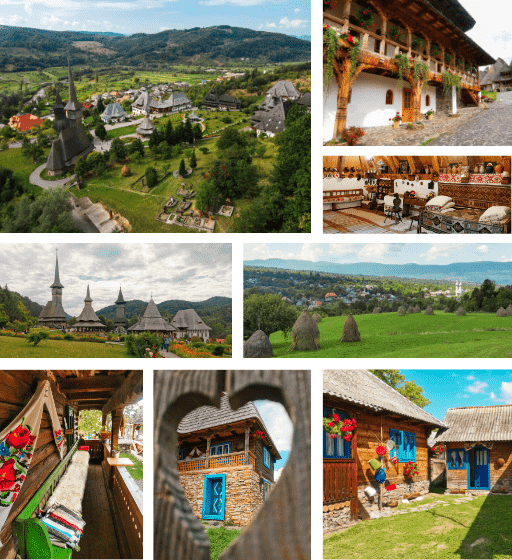
Road trip Day 11 | Painted Monasteries of Bucovina
Today’s Romania road trip route will take you through beautiful, winding mountain passes, pretty Romanian villages, and breathtaking landscapes. But the highlight of the day is exploring the painted churches & monasteries of Bucovina – UNESCO World Heritage Site since 1993. All churches are Romanian Orthodox and were built roughly between 1487 and 1583.
There are 8 Monasteries, that form part of this UNESCO site:
- Voronet*
- Moldovita*
- Sucevita*
- Arbore
- Humor
- Patrauti
- Probota
- Suceava
Of the above, the top 4 of the list are the most worth visiting. We ourselves visited three and honestly this felt like it was enough to get a gist. Of course, if you have more time, then you can attempt to see all 8, scattered throughout the region. Each church is unique in its own right and has beautiful, colorful paintings and frescoes – both inside the church as well as externally on its walls.
Each monastery has an entry fee of 10 Lei/Person and goes toward the conservation of the artworks & frescoes.
We first stopped at Voronet Monastery, famous for its blue frescoes. This blue even has its own name “Voronet blue”. Next, we headed to Moldovita Monastery, which was personally our favorite. Beautifully situated in a monastic garden, blending in with the surrounding landscape. There is a small museum in an adjacent building. Last but not least we visited Sucevita Monastery – the largest of the three we saw. With full-fledged fortified walls and an alley of cypress trees leading to its entrance, this monastery was also very impressive. The walls were meant to protect the monasteries from the Ottomans.
After a long day of driving & exploring, luckily we stayed in a little pension just 2 km from Sucevita monastery (a great base for exploring!). We were greeted in a very friendly manner and of course with an obligatory shot of palinka to welcome us to the house.
Summary:
Distance | 248 km
Drive Time | 4:35 hours
Route | Take highway 18 towards Bucovina, then 17 to get to Voronet, followed by route 176 (to Moldovita) & 17A (to Sucevita). Especially the last piece of road is beautiful and leads through stunning, hilly landscapes and through pretty, traditional villages.
Where to Sleep | Pensiunea Poiana de Vis – beautiful location – perfect as a base for exploring the painted monasteries nearby.
Where to Eat | Restaurant Hanul Mariorei for some traditional Romanian food
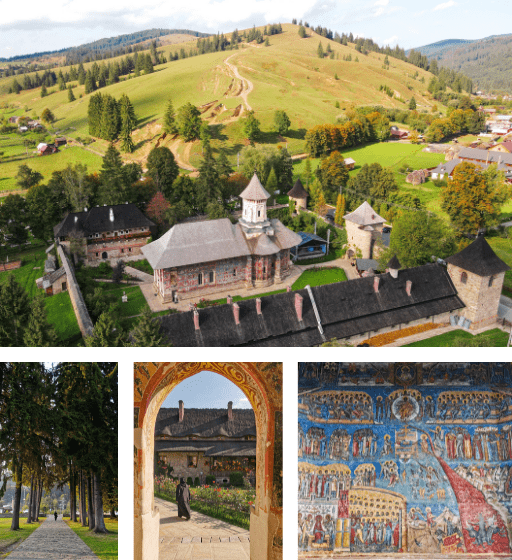
Road trip Day 12 | Hiking in Ceahlau
For our next Romania road trip segment, our host had recommended we take the beautiful highway “Transraraul” from Projorata via Chiril & Crucea. On a sidenote: Projorata supposedly has one of the best spots to eat traditionally prepared trout in all of Romania. Unfortunately, we had to take a different road, as the street had been blocked by a landslide. Our destination for the day was beautiful Ceahlau National Park, before heading back down to Bucharest.
After parking our car in Durau (home base for most hiking trails into the Ceahlau Mountains) we paid our park fee at the little ranger hut at the entrance to the park. The lady working there asked us which trail we planned to take. After telling her, she quickly told us that the distance was too far (it was already noon) and that the trail had been blocked by a landslide.
Therefore we had to take a different path and ended up hiking only to the waterfall – Cascada Duruitoarea. While the distance of the hike was not as long as we had originally planned, it was still a nice trail with some challenging bits. Once we reached the waterfall, we saw the landslide the lady had talked about. The trail further up the mountain was completely destroyed and unpassable.
Tip: make sure you ask the rangers if the trail you are planning to take is safe, to avoid disappointments & unsafe situations. If you plan to go on long hikes, make sure to start early in the morning. The mountain is quite exposed to sun and wind & distances are far.
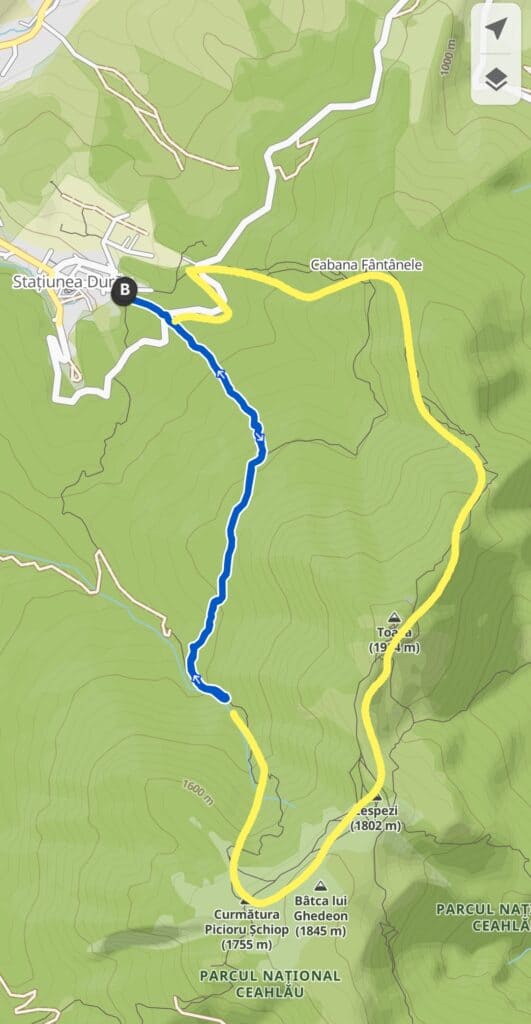
After our hike, it was early afternoon and we decided to have a cold beer at Restaurant Antia in Durau, before heading to our bed-and-breakfast further along in the park. We didn’t eat there, but the food looked great and the service was very kind. So we can definitely recommend this place in Durau.
Our destination for the evening was the small town of Izvoru Munteliu – also a popular start of several hiking trails. En-route make sure to stop by “Viewpoint Lake Izvorul Muntelui” for some stunning views of the lake.
Summary:
Distance | 171 km
Drive Time | 3:09 hours
Route | Either take the picturesque “Transraraul” Highway or alternatively the 17A & 177A; then continue on 17B, 15 & 155F. Due to partly heavy traffic (many trucks) & narrow roads, make sure you plan enough time for the drive.
Where to Sleep | Pensiunea Bia Papadia, cute bed-and-breakfast with a stunning view of the Ceahlau Massif.
Where to Eat | Restaurant Bia Papadia – delicious food!
Road trip Day 13 | From Ceahlau to Bucharest
The drive back from Ceahlau to Bucharest is long. If you have an extra couple of days to your vacation, I highly recommend heading toward the Danube Delta at this point & spending at least two more days exploring the beautiful nature and diverse wildlife there. The Danube Delta is an important breeding spot for many bird species and a popular stop for birds migrating South towards Africa, to escape the cold European winter.
If you are like us and have only two weeks – head back to Bucharest today. The drive is not spectacular but leads through many villages in the more Eastern – and poorer – part of the country. About halfway you will pass some wineries along the side of the road. Therefore, if you are a wine-lover and/or are craving some lunch, you can stop here for food, or buy some wine or grapes from local vendors.
Once approaching Bucharest, I highly recommend you drop your rental car at Otopeni airport and take a taxi into the city. Bucharest traffic is very hectic, crowded, and likely to cause some amount of stress (which you will ideally want to avoid on your last vacation days).
The easiest way to get around the city, especially for longer distances (e.g. Airport into town) is via Uber. You can download the app in advance, in order not to lose time at the airport. Taxi drivers at in Bucharest have a bad reputation for charging highly overpriced rates for taxi rides. Having an app with a selected destination & rate gives you control of the costs and allows for no room to take detours, just to raise the price.
Upon arrival, check into your hotel, freshen up, and now is the time to go explore the city in the late afternoon & evening. Whether you just want to walk around to get a feel for the town or head into the Old Town to experience the buzz of Bucharest’s nightlife, there is surely something for everyone.
Summary:
Distance | 383 km
Drive Time | 5:45 hours
Route | via DN2/E85
Where to Sleep | there are many hotels, catering to all budgets. I recommend picking a hotel near your main spots of interest in Bucharest, as the city is very big. Getting from A to B can take some time. We stayed at Le Boutique Hotel Moxa in Calea Victoriei, which is a good spot to explore from but not in the bustling & more noisy Old Center (party & nightlife hotspot).
Where to Eat | You have many options to choose from. We wanted something laid back, so we had dinner at Coclintă Brasserie featuring traditional “Romanian pies” with many different fillings to choose from. For a fine dining experience head to “the ARTIST Restaurant” and enjoy a multiple-course meal for a very decent price. Otherwise, just stroll around the streets and you will be sure to find something among the many options.
For the sweet tooth, make sure to check out “Love you Choux” or “French Revolution” for some delicious Eclairs & pastries.
Road trip Day 14 | Exploring Bucharest – Romania’s vibrant Capital
For our trip, we chose to stay in Bucharest only for 1 night, as Romania’s nature and more remote areas were of more interest to us. If you want to spend more time here to dive deeper into Bucharest’s treasures, you can easily add 1-2 more nights to your itinerary.
No matter if you are into culture, history, sightseeing, nightlife, or just want to stroll around and enjoy the city’s vibe: Bucharest has a lot to offer for anyone.
Bucharest used to be called “Little Paris” around the 1900s. This was not only due to its elegant architecture and grand boulevards. Locals greeted each other in French, were influenced by Paris fashion, and would study and travel abroad. Today Bucharest exudes a vibe of old glory days past. Its mix of shabby-chic buildings, Communist-style blocks from the Ceaucescu era, and crumbling facades of what once used to be grand palazzos make for a very unique cityscape!
The best (but not cheapest) way to get around Bucharest is by Lime Scooter. As you may have already downloaded the Uber app to get from the airport into town, you can book yourself a Lime directly in the same app. As we did not have a lot of time on our hands, this was the best way to get from A to B quickly, while still seeing a lot of the city. Especially along the main boulevards such as Calea Victoriei etc., there are extra lanes for bikes, e-Scooters, etc. so it is relatively safe to drive (if you are careful!).
Otherwise, Bucharest has a good subway system or several bus lines. If you have some more time and are staying for a few days, this may be something to look into & is definitely the cheaper means of transportation.
Things to do:
- Lipscani / Old Town: coblestone streets, cafés, restaurants and galleries. This bustling “Old Town” is a good place to begin your Bucharest city tour and get a feel for the vibe of the city. In the evenings Lipscani becomes the hotspot for nightlife – not so much for locals, but over the years more and more for tourists, incl. pubs, pub-crawling tours, etc. In Lipscani, there are many things to see:
- For a feel of “Little Paris”, check out Pasaj Macca-Villacrosse, a shopping passage from 1981 with its yellow stained glass roof.
- Carturesti Carusel: a very “instagrammable” spot in the Lipscani, this beautiful book store is a nice photo stop with a beautiful, light interior and a nice place to shop for a souvenir.
- Strada Hanul cu Tei: a hidden street in the Lipscani, bordered by antiquity stores and art galleries on both side. A must see for art-lovers!
- Hanu’ lui Manuc / Manuc’s Inn: hosting a traditional Romanian restaurant nowadays, this is a place of great historical importance. It is one of the oldest buildings of the city and at the same time one of Europe’s last “caravanserais”. In the 1800s it used to be a meeting spot along important trade routes, offering an inn to sleep & eat for travelling merchants, as well as storage for goods. It is built around a courtyard, and is a beautiful spot for lunch, dinner or just nice for taking a break.
- Stavropoleos Monastery: arguably one of the prettiest churches in Bucharest, this church dates back to 1720 and has beautiful facade with pained frescoes.
- Ceaucescu Mansion – Museum (Palatul Primăverii): home of ex-communist dictator Ceaucescu and his family, Casa Ceaucescu was built in the 1960s and today houses a museum. With 80 rooms in total, this palace stands in stark contrast to the poverty that was prevalent in many parts of Romania during the Communist era. It has a large winter garden, wine cellar, silk wallpaper, valuable artworks, expensive furniture, a swiming pool and even a cinema. The villa can only be visited with a guide and is open from Tuesday to Friday from 10 am to 5 pm. You have to book at least 24 hours in advance; you can get your tickets online here.
- Palace of Parliament: the second largest building in the world, after the Pentagon. It houses Romania’s Parliament and is worth a visit if only to grasp its sheer size. Inside you will find three Museums – Museum of the Palace, Museum of Communist Totalitarianism and the National Museum of Contemporary Art.
- National Museum of Romanian History: located in a beautiful building near the Lipscani on Calea Victoriei. Containing aftifacts from pre-history until modern times, it is a good place to learn more about Romanian history.
- Romanian Atheneum: if you are a lover of classical music, make sure to visit a beautiful concert in this magnificent building, home of the George Enescu Philharmonic Orchestra.
- George Enescu Museum: located in a beautiful art nouveau building, this Museum is dedicated to the country’s greatest classical music composer.
- Dimitrie Gusti National Village Museum: to get a feeling for the more traditional side of Bucharest or Romania, check out this large open-air museum in the West of Herastrau Park, hosting a plethora of restored, authentic historic buildings from all corners of Romania. These houses were dismantled at their place of origin and rebuilt carefully to display the traditions and regional & cultural diversity Romania has to offer.
For more inspiration on what to do in Bucharest, check out this post by the Crazy Tourist.
Another great way to discover more about Bucharest is on one of many free walking tours, many of which start in Lipscani.
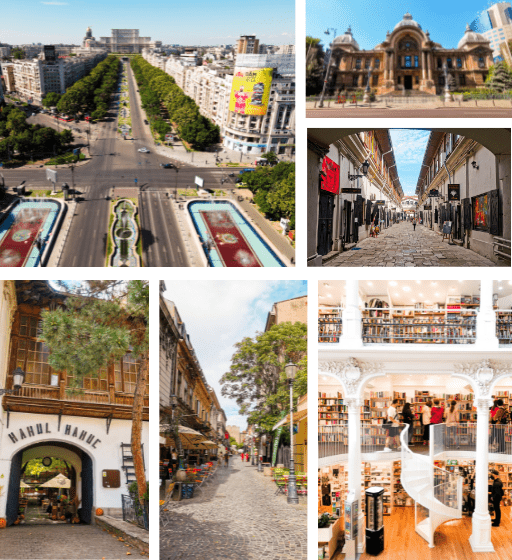
What else to see?
As we only had two weeks, unfortunately, we didn’t manage to fit in all the things we had originally wanted to see during our Romania road trip. Below, you will find four more must-see’s, that we will have to visit on our next trip to Romania 😉
- Sighisoara: Located centrally in Transylvania, Sighisoara is famous for its well-preserved walled old town, citadel & clock tower, all listed as a UNESCO World Heritage Site. Its coble-stone alleys and entire flair catapult you right back into the medieval times.
- Danube Delta: the second largest and most well-preserved river delta in Europe. Home to many lagoons, lakes, small streams, river arms and swamps, the entire ecosystem is listed as a UNESCO World Heritage Site. It is possible to visit the Delta by boat with tours or even by kayaking – most of which start from the town of Tulcea. There are over 274 bird species in the Delta, 176 of which are brooding. Another great thing to see in the Delta is Letea Forest, home to a the Danube Delta horses – a population of about 4000 “wild” horses, that live near the forest. Letea Forest itsself – the oldest natural reserve in Romania – is also very worth visiting while travelling to the Delta.
- Fortified Churches of “Siebenbürgen” / Transylvania: with over 150 well-preserved fortified churches, the south-eastern Transylvania region is home to the highest number of existing fortified churches from the 13th to 16th century. These were built in the late Middle Ages, to protect and defend the towns and churches from sieges – a danger posed especially by the rising Ottoman Empire. Seven villages are listed as UNESCO World Heritage: Biertan, Calnic, Darjiu, Prejmer, Saschiz, Valea Viilor & Viscri. Combine your visit to Transylvania with a visit to any of (or all of) these towns to get some real Medieval history into your Romania road trip itinerary.
- Timisoara: with its proximity to the Serbian and Hungarian borders, Timisoara has a distinctly different feel to it than the towns in the Transylvania & the rest of Romania. Home to 21 different ethnicities and 18 religions, Timisoara is the cultural, social and economic capital of Western Romania and well worth a visit. Nicknamed “Little Vienna” or the “City of Flowers”, Timisoara is known for its many historical monuments, green spaces & parks, universities and its many cultural institutions. The city itself is bustling, colorful and filled with bars, cafés and restaurants to rest in after a day of sightseeing. And if you are looking for more reasons to visit: Timisoara will be the European Capital of Culture in 2023. Additionally, Fun fact: Timisoara was the first mainland European city (and the second in the world after New York) to get electric street lighting!
Variations & Suggestions for your Romania Road Trip
Throughout our two weeks Romania road trip, we were fascinated by all there is to do in this country. Its picturesque countryside in the North, historic towns in Transylvania, and natural beauty in its many national parks made us wish we had even more time. Below I put together a few variations to modify your route depending on how much time you have for your Romania road trip:
1-week: Discovering Transylvania – (fly into Cluj-Napoca or Sibiu)
Unless you are taking a weekend get-away or city trip, I do not recommend visiting Romania for less than one week. There is so much to see and do, it would be a shame to miss out. If you have just one week on your hands, make sure to visit Transylvania. This includes: Sighisoara, Sibiu, Cluj-Napoca & Brasov. Fly either into Cluj-Napoca – the capital of Transylvania – or into Sibiu. I still recommend renting a car and changing your home base 2-3 times to spend the evenings in the different cities.
10 days: Transylvania + Sinaia (fly into Bucharest, Cluj-Napoca or Sibiu)
If you have 10 days, I recommend seeing Transylvania (see above) and adding Sinaia with its beautiful Peles Castle to your trip – reachable via car from Brasov. Alternatively, if you do not want to drive there yourself, there are many tour operators organizing day-trips to Peles Castle (& Bran “Dracula” Castle).
3 weeks: Add the Danube-Delta (Fly into Bucharest)
With 3 weeks’ time, I suggest you follow our 2-week itinerary (Transylvania, Sinaia, Maramures & Bucovina) & add the Danube Delta to your trip (for nature lovers). For those more into cities and culture, you can add Timisoara in the West.
4 weeks: Romania from A-Z (Fly into Bucharest)
If you are lucky enough to have a glorious 4 weeks’ time to visit this beautiful country, then you can see it all. Start in Bucharest, make your way through Transylvania, and then head West towards Timisoara. After 1-2 days there, head North via Oradea (a part of the Route Art Nouveau Europe) and visit beautiful Maramures and Bucovina. On your way back to Bucharest circle over the Danube Delta and spend some beautiful days in nature observing the hundreds of bird species and chasing the “wild horses” of Letea Forest. Head further South through Constanta – Romania’s prime seaside resort – and end your trip with 2-3 days in Bucharest. I am sure this Romania road trip will leave you with many unforgettable impressions.

Looking for more inspiration?
If you are looking for more inspiration, stay on travelousdriver.com to browse my other posts.
Planning your next spring or summer get-away and dreaming of the rolling hills of Tuscany? Check out my post about the 35 best things to do in Tuscany, Italy.
Still looking for your perfect winter get-away and longing to take beautiful pictures of the northern lights? Then don’t miss my beginner’s guide to Northern Light photography.
Have some real wanderlust? Then look no further than Namibia – a country that will absolutely take your breath away and make you fall in love with Africa. Get some inspiration here for the 40 best things to do in Namibia.
You May Also Like
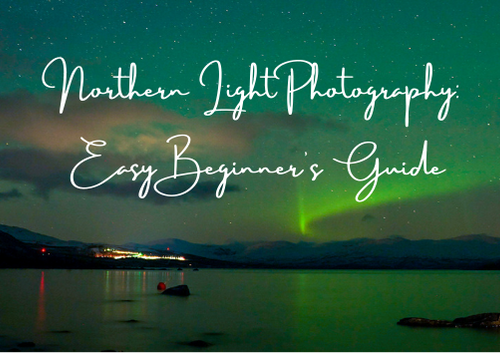
Northern Light Photography: Easy Beginner’s Guide
October 1, 2021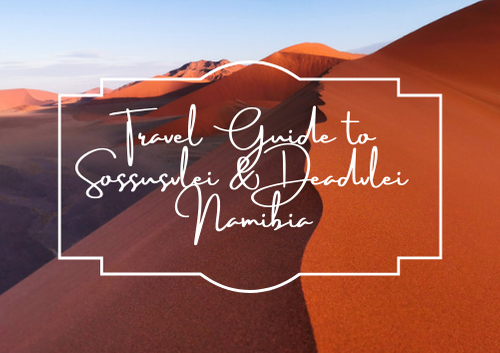
Visiting Sossusvlei & Deadvlei in Namibia: the Ultimate Travel Guide
April 5, 2021